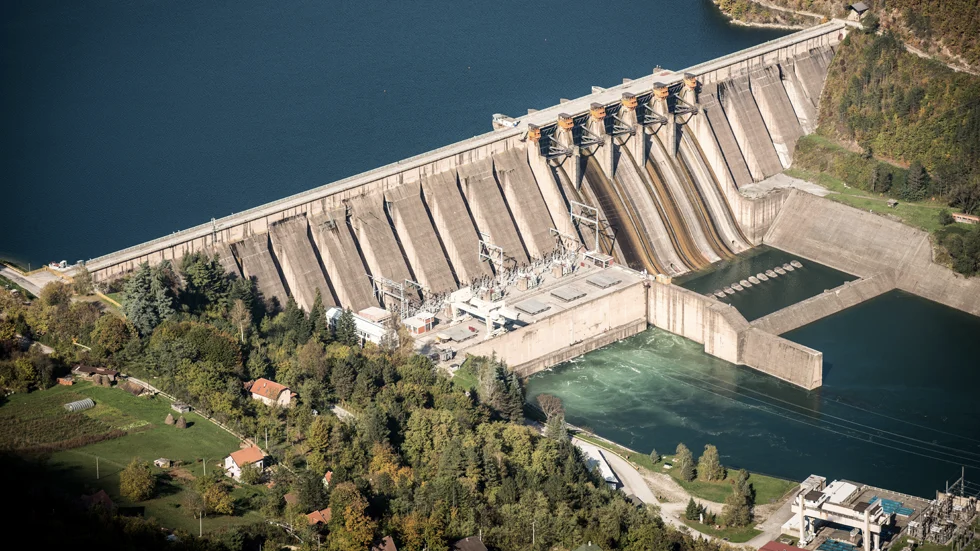· 5 min read
According to a new International Energy Agency report, achieving the Paris Agreement’s climate goals requires more low-carbon hydrogen to fuel transport and industry. This emerging demand for hydrogen might unlock one of Africa’s untapped riches, the massive hydropower from the proposed Grand Inga dam (Inga). Reconfiguring the dam’s plan to add hydrogen production could help make the project a reality. It is also an option the Biden administration should consider examining under its new climate finance plan.
As the Congo River winds its way through the Democratic Republic of Congo (DRC), it reaches Inga Falls, the site with the world’s largest hydropower potential. The location (which I visited for the World Bank) can produce 40,000 megawatts (MW) of electricity — more than the world’s two biggest hydropower plants, Three Gorges and Itaipu, combined. To date, however, only two smaller dams have been built there, with a total installed capacity of just 1,800 MW.
For decades, visions of Grand Inga providing clean electricity throughout Africa have tantalized power planners, governments and development experts. But the project is controversial, as the environmental and social concerns surrounding large dams are amplified by DRC’s governance issues.
Grand Inga’s projected output is so large it would require a transmission network extending from South Africa to Nigeria and beyond to reach enough customers to purchase all its electricity. Its sales, as a result, would be vulnerable to physical and political disruption as the electricity crosses numerous countries. Sales would also largely depend on distant customers located in markets with creditworthiness issues. These risks, coupled with the problematic governance context, have prevented DRC from raising the tens of billions of dollars needed to construct Grand Inga.
Over the years, different sponsors have expressed interest in an intermediate dam, Inga 3, sized at 4,800 MW and 11,050 MW under different configurations and largely anchored by exports to South Africa, a market which has become financially stressed. Given daunting market risks, the multi-billion dollar Inga 3 has failed to advance materially.
Adding hydrogen production might help unblock Inga. Low-carbon hydrogen has been gaining attention as a clean fuel. Green hydrogenproduced through electrolysis of water using renewables-fueled electricity, including hydropower, is especially valued for climate, with an export market potentially growing to $300 billion by 2050.
Importantly, hydrogen can be transported and stored. Once produced, green hydrogen (or, alternatively, ammonia, a derivative product) can be put on ships destined to creditworthy purchasers, much like liquefied natural gas. Instead of sending electricity on long transmission lines to fragile markets, the power could be dispatched to nearby manufacturing plants to produce green hydrogen which is then shipped to investment-grade markets worldwide.
Fueled by the massive water flow of the Congo River, which is second only to the Amazon, Grand Inga could generate a large constant renewable electricity output, at a magnitude exceeding other large-scale green hydrogen proposals and a projected cost of $0.03/kWh. These factors could make Inga’s hydrogen competitive, particularly with further innovations. Inga’s output would be big enough to power hydrogen production for export and DRC’s domestic uses. The project can be phased to stagger investment requirements and match maturation of the hydrogen market.
A hydrogen-producing Inga can offer strengthened project economics to investors and increase the global supply of low-carbon fuels, but it must first and foremost advance equitable development in DRC — which, unfortunately, remains a formidable challenge.
First, the project’s environmental and social impacts need to be addressed, including protecting affected communities and managing the dam’s direct impact on greenhouse gas emissions. Second, a meaningful share of Inga’s electricity should be dedicated to powering local businesses and social services and raising electricity access rates. Third, engaging local communities is essential.
Although the country’s transition to President Tshisekedi (who recently spoke at the U.S.-organized Leaders Summit on Climate) may provide an opportunity to rebuild international support for the project, serious governance concerns persist. Solid safeguards are required for this issue, including robust mechanisms to mitigate corruption risks and to channel revenues to poverty alleviation.
The World Bank and African Development Bank have roles to play supporting all these elements — but this requires the Tshisekedi government to remedy the transparency issues that led the World Bank to cancel its support for Inga 3 back in 2016. For the development banks, hydrogen may provide a way to help Africa monetize its extensive renewable resources, especially as assistance for fossil fuels diminishes.
The U.S. can also assist in various ways. President Biden recently announced a U.S. International Climate Finance Plan to increase funding to developing countries for the low-carbon transition. Under the plan’s “whole-of-government approach,” different parts of the administration could play complementary roles in examining the hydrogen-Inga option. For example, the Development Finance Corporation could fund feasibility studies, while the Treasury Department engages the multilateral development banks and the State Department evaluates the political dimensions. In subsequent phases, U.S. action to support robust governance and corruption safeguards will likely also be needed.
U.S. engagement could advance several administration objectives, such as expanding Africa’s power sector and mobilizing private investment for clean energy. Moreover, if adding hydrogen can attract substantial private sector funding for Grand Inga, as well as climate finance from the G-7, it might provide an alternative to the Chinese state-owned enterprise approach being proposed for Inga 3.
Under the right conditions, a reconfigured Inga project could generate multiple wins, notably on climate by producing a green fuel, and for Africa’s development by generating export revenues, providing additional clean electricity for local use and raising access rates. Although the prospects for ultimately launching the project are uncertain given the governance context and other challenges, a Grand Inga-green hydrogen configuration merits examination.
Energy Voices is a democratic space presenting the thoughts and opinions of leading Energy & Sustainability writers, their opinions do not necessarily represent those of illuminem.






